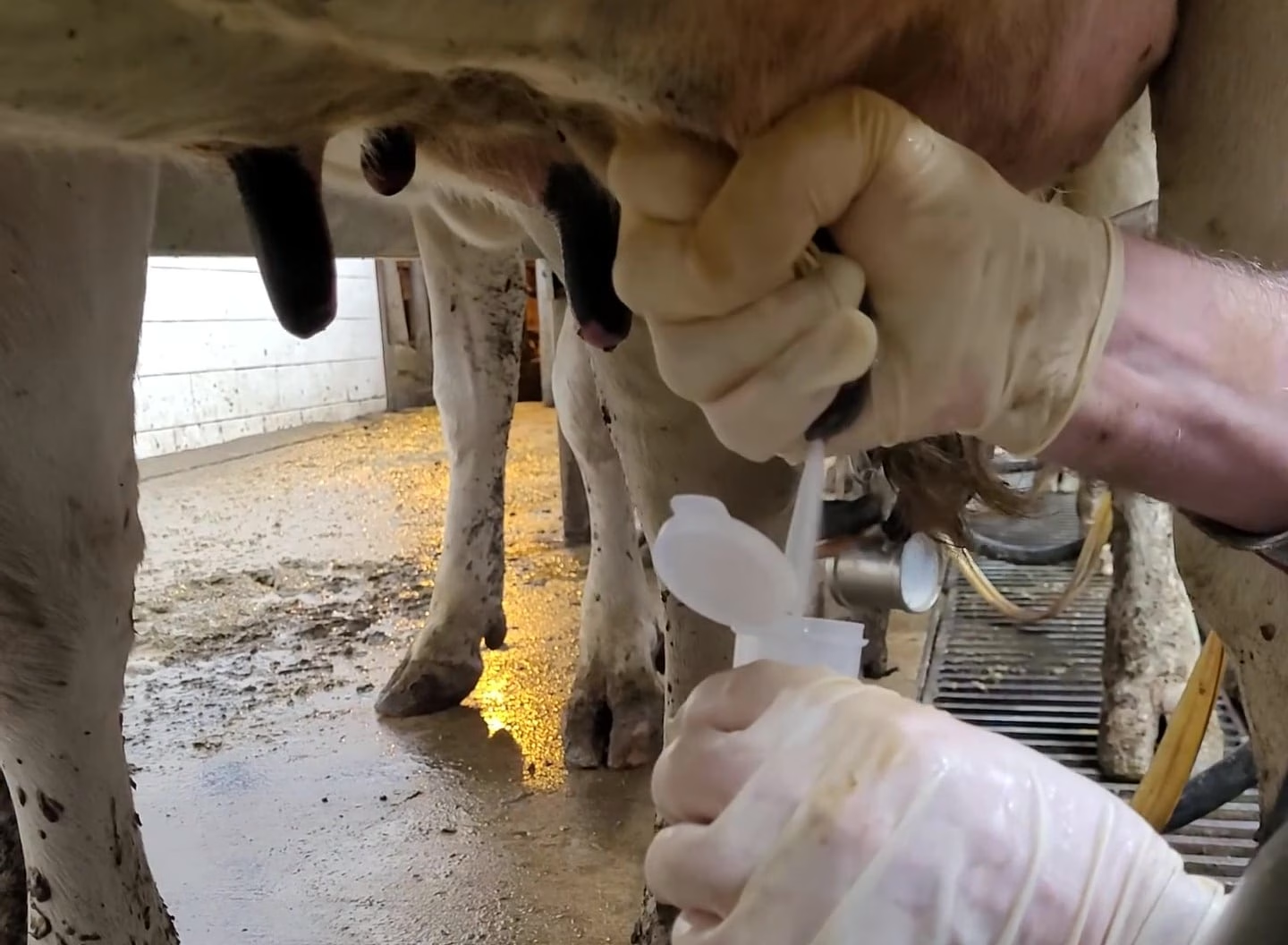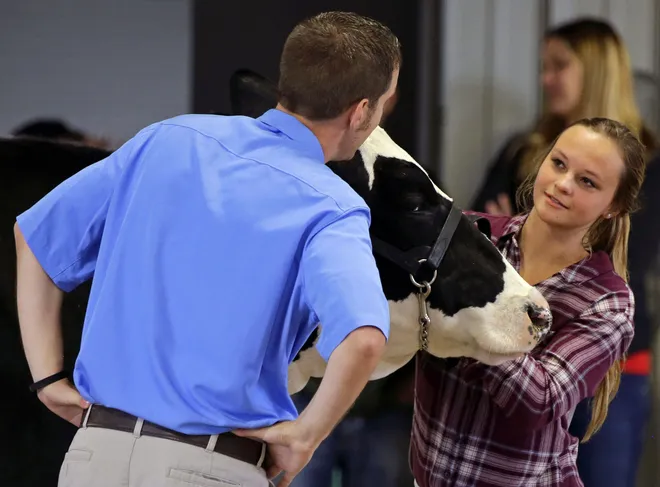Will the USDA’s new compensation for H5N1 losses inspire dairy farmers to take a more proactive approach to herd testing? Will this increased vigilance lead to improved dairy herd health?

Imagine losing up to 20% of your milk production overnight. This nightmare could become a reality for many dairy farmers as the H5N1 highly pathogenic avian influenza threatens their herds. Despite the risk, many dairy farmers still hesitate to test their herds. As of July 1st, the USDA offers financial relief by compensating dairy farmers for lost milk production if their herds are infected with this devastating virus. This program is a lifeline and a beacon of hope, providing compensation covering up to 90% of losses and offering a significant financial buffer. The question remains: will this encourage producers to test more? Will this program help increase testing?
Bird Flu’s Unexpected Impact: A Crisis for Dairy Farmers Amid H5N1 Outbreaks
Since its identification, the H5N1 highly pathogenic avian influenza (HPAI), often called bird flu, has posed significant threats to agriculture and public health. Primarily affecting poultry, this virus can also infect mammals, including humans, albeit rarely. The Centers for Disease Control and Prevention (CDC) keeps tracking and managing its spread. Forty-two dairy herds in nine states have been impacted, underscoring the urgency and challenge of this crisis in the agricultural sector.
Research and field reports suggest that dairy cows infected with H5N1 or exposed to the virus through environmental contamination can reduce milk production by as much as 10-20%. This reduction can be attributed to factors such as fever, reduced feed intake, and overall poor health of the animals.
Reluctance and Concerns: Understanding Dairy Farmers’ Hesitancy to Test for H5N1
Dairy herd testing numbers reveal a notable hesitancy among dairy farmers to test their livestock for H5N1 Avian Influenza. Several factors contribute to this reluctance. The financial burden of testing can be significant, especially for smaller operations. Testing procedures can stress animals and temporarily decrease milk production, impacting immediate revenue. A positive result could mean quarantine or culling, causing further economic loss and operational disruptions.
Additionally, dairy farmers must understand that early detection and mitigation are potent tools in the fight against H5N1 avian influenza. Fear of public knowledge of an infection harming their reputation and reducing market demand, despite bird flu’s non-transmissibility to humans in the context of dairy products, is a valid concern. However, this fear can be mitigated through comprehensive support and effective communication about early detection and mitigation benefits, empowering farmers to take proactive steps.
USDA’s Compensation Blueprint: Financial Relief for Dairy Farmers Amid H5N1 Outbreak
The USDA has clearly defined the compensation program to help dairy farmers impacted by H5N1 avian influenza. Eligibility is simple: herds must be confirmed as infected with H5N1, adhering to USDA diagnostic standards for consistency and accuracy.
Farmers should apply through the Farm Service Agency (FSA), utilizing online forms from the FSA’s website or local offices. Applications must include vet reports, diagnostic test results, and detailed records of lost milk production due to the outbreak.
After submission, program administrators will review the documentation. The program promises to cover up to 90% of milk-production losses, easing the financial burden on dairy farmers and supporting their recovery amid the H5N1 crisis.
Challenges in the Current Testing Practices for H5N1 in Dairy Herds
Current testing for H5N1 in dairy herds follows federal and state guidelines that mandate routine surveillance and prompt reporting of suspected cases. Typically, this involves regular sampling and laboratory testing of symptomatic animals, with high-risk areas requiring more frequent monitoring.
Nonetheless, several challenges undermine these testing protocols. Financial constraints limit smaller dairy farms’ ability to perform frequent tests, and sampling many animals presents operational difficulties. A lack of rapid testing facilities in rural areas delays results, complicating timely decisions.
Administrative delays in approvals and compensations further reduce farmers’ incentive to test. Additionally, the stigma of an HPAI outbreak can deter reporting due to fears of economic and reputational damage. These barriers create gaps in surveillance, hindering early detection and containment of H5N1 in dairy herds.
Incentivizing Vigilance: Will USDA’s Compensation Drive Higher H5N1 Testing Rates Among Dairy Herds?
The USDA’s compensation program for dairy farmers, which will reimburse up to 90% of milk-production losses due to H5N1 infections, is expected to significantly boost testing rates among dairy herds. This financial incentive provides a compelling reason for farmers to test for H5N1, alleviating their economic concerns.
This program offers crucial financial support. Dairy farmers often struggle with slim profit margins, and an outbreak can wreak economic havoc. The promise of substantial reimbursement eases this burden, encouraging farmers to test and report infections rather than silently endure losses or underreport issues.
Operationally, guaranteed compensation supports proactive biosecurity and health monitoring on farms. Rigorous testing ensures early detection and containment, preventing widespread outbreaks. The USDA’s policy allows farmers to implement and maintain thorough testing protocols without fearing financial collapse, fostering sustainable herd management.
Health-wise, incentivizing regular testing through financial compensation also supports public health. Detecting H5N1 early within herds reduces both animal spread and zoonotic transmission, aligning with broader public health objectives to control avian influenza and protect both animal and human populations.
The USDA’s program is poised to be a strong catalyst for increased H5N1 testing among dairy farmers. It aims to create a more resilient and responsive agricultural sector by addressing financial, operational, and health concerns.
Expert Opinions Highlight Potential Surge in H5N1 Testing Among Dairy Farmers Due to USDA’s Compensation Initiative
Experts highlight the significant impact of the USDA’s compensation initiative on dairy farmers’ testing behaviors. Dr. Marlene Wolfe, a veterinary epidemiologist at Emory University, states, “Financial incentivization is a potent motivator. By offering compensation for losses due to H5N1, the USDA directly addresses the economic fears that deter farmers from seeking testing.” Monica Schoch-Spana, a medical anthropologist at Johns Hopkins, adds that economic security significantly influences compliance with health measures. Dairy farmer James Rodriguez from Wisconsin notes, “The promise of up to 90% compensation for lost milk production could be a game-changer. Knowing the financial hit from an H5N1 outbreak can be mitigated makes it more likely we’ll invest in regular testing.” Similarly, Dr. Amy Maxmen from the CDC highlights that such programs encourage proactive health measures, asserting, “When farmers are confident their livelihoods are protected, they are more likely to participate in early detection efforts, crucial for controlling the virus’s spread.” This combination of expert opinions and practical experiences suggests the USDA’s compensation program will likely enhance vigilance and testing rates among dairy farmers, fostering a more resilient sector amidst the H5N1 crisis.
A Comprehensive Look at the Implications of Increased Testing and Compensation within the Dairy Industry
The implications of increased testing and compensation within the dairy industry are multifaceted. USDA’s financial incentives likely encourage more dairy farmers to engage in H5N1 testing, promoting proactive health management. This improves herd health by swiftly identifying and isolating infected animals, curbing virus spread, and reducing livestock health impacts.
The program covers up to 90% of milk production losses, allowing farmers to sustain operations without severe financial strain. This support is crucial for smaller dairy farms that might otherwise struggle to recover from such losses.
Widespread testing and compensation may drive industry standardization in health practices, enhancing the quality and safety of milk products for consumers. USDA’s intervention could bolster market stability, reassuring domestic and international markets of the U.S. dairy supply chain’s reliability during health crises.
However, this raises questions about the long-term sustainability of such compensations and potential dependency on government aid. While immediate economic relief is beneficial, a balanced approach is needed to foster resilience within the industry and encourage sustainable health practices and self-reliance.
USDA’s compensation initiative for H5N1-affected dairy farmers is a step towards better herd health, sustained milk production, and market stability. It also underscores the need for long-term strategies to maintain these benefits and ensure the dairy industry’s robustness against future outbreaks.
The Bottom Line
The USDA’s initiative to compensate dairy farmers for H5N1-related losses could reshape disease management in the dairy industry. By offering financial relief, the program aims to ease economic distress and encourage proactive testing among dairy producers, highlighting the crucial role of monetary incentives in promoting public health vigilance.
Throughout this analysis, we’ve examined the H5N1 outbreak’s impact on dairy farms, farmers’ hesitation to test regularly, the USDA’s financial support framework, and challenges in current testing practices. Experts agree that monetary compensation will likely boost H5N1 testing in dairy herds, indicating a move towards better biosecurity measures.
The critical question is whether the USDA’s compensation program can significantly increase H5N1 testing on dairy farms. Financial incentives might reduce farmers’ reluctance, but lasting success depends on ongoing education, streamlined testing, and sustained government support. Moving forward, stakeholders in the dairy industry must stay vigilant against health threats. The USDA’s program is essential, but a continuous commitment to disease prevention and quick action is crucial. We urge dairy farmers to seize this opportunity to protect their livelihoods and strengthen the agricultural sector against zoonotic diseases.
Key Takeaways:
- USDA’s compensation program starts on July 1st and aims to support dairy farmers affected by H5N1.
- Dairy farmers with confirmed H5N1 infections can apply for compensation through the Farm Service Agency.
- The program covers up to 90% of milk-production losses for farms hit by the H5N1 outbreak.
- This initiative may increase the incentive for dairy herds to test for H5N1, potentially elevating testing rates and early detection.
- Expert opinions suggest that financial relief programs could increase the number of dairy farms undergoing H5N1 testing.
- Enhanced vigilance through increased testing might lead to better management of H5N1 outbreaks within the dairy sector, thereby mitigating broader economic impacts.
Summary:
The H5N1 highly pathogenic avian influenza (HPAI), also known as bird flu, poses significant threats to agriculture and public health. With 42 dairy herds in nine states affected, the Centers for Disease Control and Prevention (CDC) manages its spread. Research suggests that dairy cows infected with H5N1 or exposed to the virus through environmental contamination can reduce milk production by 10-20% due to factors such as fever, reduced feed intake, and poor animal health. However, dairy herd testing numbers reveal a notable hesitancy among dairy farmers to test their livestock for H5N1. Factors contributing to this reluctance include the financial burden of testing, which can stress animals and temporarily decrease milk production, impacting immediate revenue. The USDA has defined a compensation program to help dairy farmers affected by H5N1 avian influenza. Eligibility is simple: herds must be confirmed as infected with H5N1, adhering to USDA diagnostic standards. The USDA’s compensation program is expected to significantly boost testing rates among dairy herds, alleviate economic concerns, and support proactive biosecurity and health monitoring on farms.












